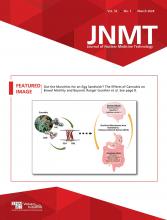Abstract
Imaging of brain β-amyloid plaques with 18F-labeled tracers for PET will likely be available in clinical practice to assist the diagnosis of Alzheimer disease (AD). With the rapidly growing prevalence of AD as the population ages, and the increasing emphasis on early diagnosis and treatment, brain amyloid imaging is set to become a widely performed investigation. All physicians reading PET scans will need to know the complex relationship between amyloid and cognitive decline, how to best acquire and display images for detection of amyloid, and how to recognize the patterns of tracer binding in AD and other causes of dementia. This article will provide nuclear medicine physicians with the background knowledge required for understanding this emerging investigation, including its appropriate use, and prepare them for practical training in scan interpretation.
Footnotes
↵* NOTE: FOR CE CREDIT, YOU CAN ACCESS THIS ACTIVITY THROUGH THE SNMMI WEB SITE (http://www.snmmi.org/ce_online) THROUGH MARCH 2015. PARTICIPANTS WHO HAVE ALREADY TAKEN THE EXAM USING JNM AND PASSED CANNOT RETAKE THE EXAM.
Published online ▪▪▪▪







